Last Saturday, 6 June 2015, British stage and screen actor and producer Richard Johnson has died, aged 87. He conferred his dark, handsome, saturnine features, assertive jaw, emphatic eyebrows and air of intelligence on scores of classic parts in the theatre, and on a wide range of film and television roles. Johnson was considered for the role of James Bond in the first Bond film, Dr. No (1962). He declined the part as he did not favour a lengthy contract.
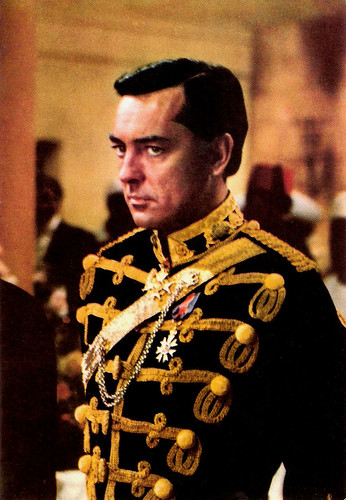
Italian postcard. Photo: Dear Film. Publicity still for Khartoum (Basil Dearden, Eliot Elisofon, 1965).
Richard Keith Johnson was born in Upminster, Essex, in 1927, the son of Frances Louisa Olive (née Tweed) and Keith Holcombe Johnson. He was educated at Parkfield School and Felsted School before training for the stage at Rada. He claimed to have started acting as a child and then became a professional actor because it made him feel alive and less aware of his ‘insufficiencies’.
During the Second World War, he served in the Royal Navy. His career began with a walk-on part in John Gielgud’s 1944 production of Hamlet in Manchester. He moved to the West End as part of a classical repertoire at the Haymarket where he took small parts in 'Love for Love', 'The Circle', and 'The Duchess of Malfi'. After a season of old melodrama in Camden Town, he was in two West End productions, 'The Madwoman of Chaillot' and 'After My Fashion', as well as open-air Shakespeare in Regent’s Park, before a season with the Bristol Old Vic company in 1953.
He spent the next season in broadcasting, but in 1955 he got his first real break in Jean Anouilh’s version of the Joan of Arc story, 'The Lark', playing Warwick, one of his favourite parts, to Dorothy Tutin’s Joan. A few months later he was cast as Laertes in Peter Brook’s production of 'Hamlet', starring Paul Scofield (1955).
After two more West End productions, playing Jack Absolute in 'The Rivals' and Lord Plynlimmon in 'Plaintiff in a Pretty Hat', he joined the Shakespeare Memorial Theatre at Stratford-upon-Avon. Among his roles were Orlando in 'As You Like It', Mark Antony in 'Julius Caesar', Leonatus in 'Cymbeline' and Ferdinand in 'The Tempest', which transferred to Drury Lane in 1957. The following season he played Romeo and Sir Andrew Aguecheek as well as the title role in 'Pericles' and Don John in 'Much Ado About Nothing', visiting Moscow and Leningrad as Romeo and Aguecheek.
During the 1960s Johnson became involved with Sir Peter Hall’s production of 'Cymbeline', leading to Hall inviting him to join him in the Royal Shakespeare Company. There, in 1961, he acted Hans in Jean Giraudoux’s 'Ondine'. He also gave one of his finest performances as Urbaine in John Whiting’s 'The Devils', a study of 17th-century witchcraft directed by Peter Brook.
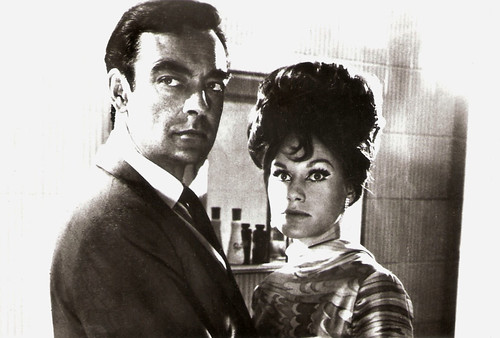
Romanian postcard by Casa Filmului Acin. Photo: publicity still for Deadlier than the male (Ralph Thomas, 1967) with Suzanna Leigh.
In 1959, Richard Johnson made his film debut in a major co-star role in the MGM war drama Never So Few (John Sturges, 1959), starring Frank Sinatra and Gina Lollobrigida. Subsequently, he was contracted by MGM to appear in 1 film per year over 6 years. There he made his biggest films including Robert Wise’s The Haunting (1963), The Pumpkin Eater (Jack Clayton, 1964) and Khartoum (Basil Dearden, Eliot Elisofon, 1966), starring Laurence Olivier and Charlton Heston.
In the early 1960s, the director Terence Young had wanted Johnson to play James Bond in preference to Sean Connery. Johnson declined because he was under contract to MGM and did not relish the seven-year commitment. If the stardom for which his career seemed to be heading in the cinema of the early 1960s eluded him, he cut a dashingly romantic figure opposite Kim Novak, whom he married in real life at this time (albeit briefly – they divorced a year later), in the all-star romp, The Amorous Adventures of Moll Flanders (Terence Johnson, 1965).
Johnson certainly displayed Bond-like qualities in some of his film roles, notably when he played a modern-day Bulldog Drummond (reimagined as a 007-type hero) in Deadlier Than the Male (Ralph Thomas, 1967) with Elke Sommer and Sylva Koscina and its less satisfactory sequel, Some Girls Do (Ralph Thomas, 1969) with Daliah Lavi.
In 1969 he founded a production company called Pageant Entertainments Ltd. Its earliest productions included John Aubrey’s Brief Lives at the Criterion (1969). His feature films included the thriller Danger Route (Seth Holt, 1967), Oedipus the King (Philip Saville, 1968), Le calde notti di Lady Hamilton/Lady Hamilton (Christian-Jaque, 1968) starring Michèle Mercier, Julius Caesar (Stuart Burge, 1970), and Hennessy (Don Sharp, 1975) for which he also wrote the original story.
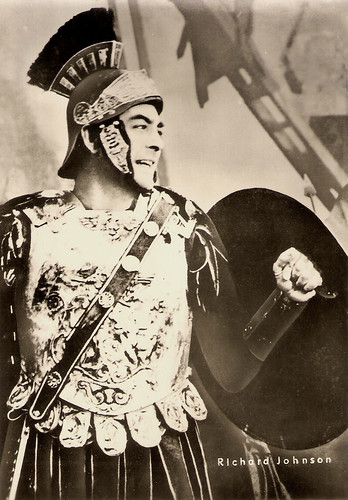
East-German postcard by VEB Progress Filmvertrieb, Berlin, no. 237/70. Photo: publicity still for Columna/Trajan's Column (Mircea Dragan, 1968).
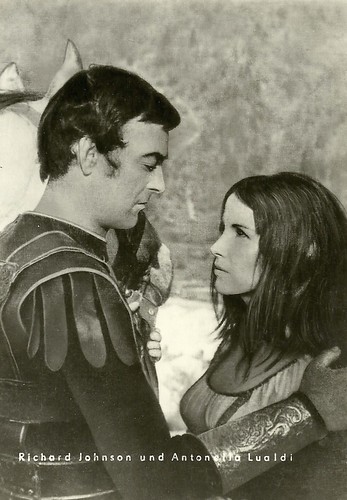
East-German postcard by VEB Progress Filmvertrieb, Berlin, no. 237/70. Photo: publicity still for Columna/Trajan's Column (Mircea Dragan, 1968) with Antonella Lualdi.
Returning to the Royal Shakespeare Company in 1972, Richard Johnson played (both at Stratford and in London) Mark Antony in 'Julius Caesar', and Antony in Trevor Nunn’s 'Antony and Cleopatra' (opposite Janet Suzman), a performance variously described as “fruity”, “genial” and “declining into a business ruffian”, but also firmly defining the warrior’s handsome gravity.
After starring in a West End musical comedy, 'Thomas and the King', in 1975, in which he played Thomas, he joined the National Theatre Company for a couple of seasons, showing, again under Peter Hall’s direction, a sharp gift for farce in Noël Coward’s 'Blithe Spirit' and playing Pontius Pilate in 'The Passion' (1977), Pinchwife in Wycherley’s 'The Country Wife' (1977) and Nendor in 'The Guardsman' in 1978.
He went on to appear in such films as The Four Feathers (Don Sharp, 1978). He also appeared in several Italian films, including Lucio Fulci's cult classic, Zombi 2/Zombie (1979) which was banned for some years, and L'isola degli uomini pesce/Island of the Fishmen (Sergio Martino, 1979) with Barbara Bach.
In 1983 Johnson became founder, chairman, and joint chief executive of a production company, United Artists, with Diana Rigg as director, and the actors Albert Finney and Glenda Jackson. They promoted such films as Turtle Diary (John Irvin, 1985) starring Glenda Jackson and Ben Kingsley, Castaway (Nicolas Roeg, 1986) with Oliver Reed, and The Lonely Passion of Judith Hearne (Jack Clayton, 1987) starring Maggie Smith.
He made something of a comeback at Stratford-on-Avon in 1992 as Antony in 'Antony and Cleopatra', having two years earlier re-established himself on the television screen in two plays, The Camomile Lawn and Anglo-Saxon Attitudes. In later years, he was a charismatic presence in television productions such as Midsomer Murders, Waking the Dead, Silent Witness and Doc Martin. His later films include Lara Croft: Tomb Raider (Simon West, 2001) and The Boy in the Striped Pyjamas (Mark Herman, 2008). His last known film appearance was in Radiator (Tom Browne, 2014).
Richard Johnson was married four times; first, in 1957 to the actress Sheila Sweet, by whom he had a son and daughter (the photographer, Sukey Parnell). After their divorce, he married, in 1965, Kim Novak, a marriage which lasted a few months. In 1982 he married Mary-Louise Norlund, by whom he had a daughter. He also had a son with the French actress, Françoise Pascal. His fourth wife was Lynne Gurney, whom he married on a beach in Goa in 2004. She survives him with his four children and his stepson, the actor Paris Arrowsmith. Johnson’s family said he died on Saturday in the Royal Marsden Hospital in Chelsea, West London, after a short illness.
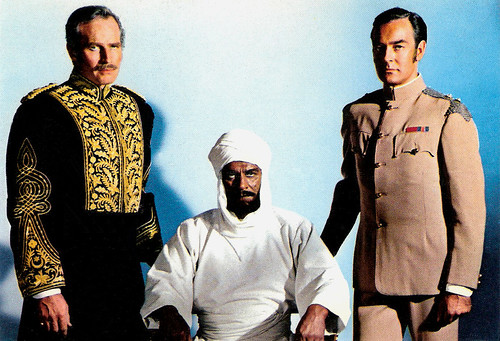
Italian postcard. Photo: Dear Film. Publicity still for Khartoum (Basil Dearden, Eliot Elisofon, 1965) with Charlton Heston and Laurence Olivier.
Sources: The Telegraph, The New York Times, The Guardian, Wikipedia and IMDb.
This post was last updated on 24 November 2024.

Italian postcard. Photo: Dear Film. Publicity still for Khartoum (Basil Dearden, Eliot Elisofon, 1965).
One of his finest performances
Richard Keith Johnson was born in Upminster, Essex, in 1927, the son of Frances Louisa Olive (née Tweed) and Keith Holcombe Johnson. He was educated at Parkfield School and Felsted School before training for the stage at Rada. He claimed to have started acting as a child and then became a professional actor because it made him feel alive and less aware of his ‘insufficiencies’.
During the Second World War, he served in the Royal Navy. His career began with a walk-on part in John Gielgud’s 1944 production of Hamlet in Manchester. He moved to the West End as part of a classical repertoire at the Haymarket where he took small parts in 'Love for Love', 'The Circle', and 'The Duchess of Malfi'. After a season of old melodrama in Camden Town, he was in two West End productions, 'The Madwoman of Chaillot' and 'After My Fashion', as well as open-air Shakespeare in Regent’s Park, before a season with the Bristol Old Vic company in 1953.
He spent the next season in broadcasting, but in 1955 he got his first real break in Jean Anouilh’s version of the Joan of Arc story, 'The Lark', playing Warwick, one of his favourite parts, to Dorothy Tutin’s Joan. A few months later he was cast as Laertes in Peter Brook’s production of 'Hamlet', starring Paul Scofield (1955).
After two more West End productions, playing Jack Absolute in 'The Rivals' and Lord Plynlimmon in 'Plaintiff in a Pretty Hat', he joined the Shakespeare Memorial Theatre at Stratford-upon-Avon. Among his roles were Orlando in 'As You Like It', Mark Antony in 'Julius Caesar', Leonatus in 'Cymbeline' and Ferdinand in 'The Tempest', which transferred to Drury Lane in 1957. The following season he played Romeo and Sir Andrew Aguecheek as well as the title role in 'Pericles' and Don John in 'Much Ado About Nothing', visiting Moscow and Leningrad as Romeo and Aguecheek.
During the 1960s Johnson became involved with Sir Peter Hall’s production of 'Cymbeline', leading to Hall inviting him to join him in the Royal Shakespeare Company. There, in 1961, he acted Hans in Jean Giraudoux’s 'Ondine'. He also gave one of his finest performances as Urbaine in John Whiting’s 'The Devils', a study of 17th-century witchcraft directed by Peter Brook.

Romanian postcard by Casa Filmului Acin. Photo: publicity still for Deadlier than the male (Ralph Thomas, 1967) with Suzanna Leigh.
Deadlier than the male
In 1959, Richard Johnson made his film debut in a major co-star role in the MGM war drama Never So Few (John Sturges, 1959), starring Frank Sinatra and Gina Lollobrigida. Subsequently, he was contracted by MGM to appear in 1 film per year over 6 years. There he made his biggest films including Robert Wise’s The Haunting (1963), The Pumpkin Eater (Jack Clayton, 1964) and Khartoum (Basil Dearden, Eliot Elisofon, 1966), starring Laurence Olivier and Charlton Heston.
In the early 1960s, the director Terence Young had wanted Johnson to play James Bond in preference to Sean Connery. Johnson declined because he was under contract to MGM and did not relish the seven-year commitment. If the stardom for which his career seemed to be heading in the cinema of the early 1960s eluded him, he cut a dashingly romantic figure opposite Kim Novak, whom he married in real life at this time (albeit briefly – they divorced a year later), in the all-star romp, The Amorous Adventures of Moll Flanders (Terence Johnson, 1965).
Johnson certainly displayed Bond-like qualities in some of his film roles, notably when he played a modern-day Bulldog Drummond (reimagined as a 007-type hero) in Deadlier Than the Male (Ralph Thomas, 1967) with Elke Sommer and Sylva Koscina and its less satisfactory sequel, Some Girls Do (Ralph Thomas, 1969) with Daliah Lavi.
In 1969 he founded a production company called Pageant Entertainments Ltd. Its earliest productions included John Aubrey’s Brief Lives at the Criterion (1969). His feature films included the thriller Danger Route (Seth Holt, 1967), Oedipus the King (Philip Saville, 1968), Le calde notti di Lady Hamilton/Lady Hamilton (Christian-Jaque, 1968) starring Michèle Mercier, Julius Caesar (Stuart Burge, 1970), and Hennessy (Don Sharp, 1975) for which he also wrote the original story.

East-German postcard by VEB Progress Filmvertrieb, Berlin, no. 237/70. Photo: publicity still for Columna/Trajan's Column (Mircea Dragan, 1968).

East-German postcard by VEB Progress Filmvertrieb, Berlin, no. 237/70. Photo: publicity still for Columna/Trajan's Column (Mircea Dragan, 1968) with Antonella Lualdi.
Zombie
Returning to the Royal Shakespeare Company in 1972, Richard Johnson played (both at Stratford and in London) Mark Antony in 'Julius Caesar', and Antony in Trevor Nunn’s 'Antony and Cleopatra' (opposite Janet Suzman), a performance variously described as “fruity”, “genial” and “declining into a business ruffian”, but also firmly defining the warrior’s handsome gravity.
After starring in a West End musical comedy, 'Thomas and the King', in 1975, in which he played Thomas, he joined the National Theatre Company for a couple of seasons, showing, again under Peter Hall’s direction, a sharp gift for farce in Noël Coward’s 'Blithe Spirit' and playing Pontius Pilate in 'The Passion' (1977), Pinchwife in Wycherley’s 'The Country Wife' (1977) and Nendor in 'The Guardsman' in 1978.
He went on to appear in such films as The Four Feathers (Don Sharp, 1978). He also appeared in several Italian films, including Lucio Fulci's cult classic, Zombi 2/Zombie (1979) which was banned for some years, and L'isola degli uomini pesce/Island of the Fishmen (Sergio Martino, 1979) with Barbara Bach.
In 1983 Johnson became founder, chairman, and joint chief executive of a production company, United Artists, with Diana Rigg as director, and the actors Albert Finney and Glenda Jackson. They promoted such films as Turtle Diary (John Irvin, 1985) starring Glenda Jackson and Ben Kingsley, Castaway (Nicolas Roeg, 1986) with Oliver Reed, and The Lonely Passion of Judith Hearne (Jack Clayton, 1987) starring Maggie Smith.
He made something of a comeback at Stratford-on-Avon in 1992 as Antony in 'Antony and Cleopatra', having two years earlier re-established himself on the television screen in two plays, The Camomile Lawn and Anglo-Saxon Attitudes. In later years, he was a charismatic presence in television productions such as Midsomer Murders, Waking the Dead, Silent Witness and Doc Martin. His later films include Lara Croft: Tomb Raider (Simon West, 2001) and The Boy in the Striped Pyjamas (Mark Herman, 2008). His last known film appearance was in Radiator (Tom Browne, 2014).
Richard Johnson was married four times; first, in 1957 to the actress Sheila Sweet, by whom he had a son and daughter (the photographer, Sukey Parnell). After their divorce, he married, in 1965, Kim Novak, a marriage which lasted a few months. In 1982 he married Mary-Louise Norlund, by whom he had a daughter. He also had a son with the French actress, Françoise Pascal. His fourth wife was Lynne Gurney, whom he married on a beach in Goa in 2004. She survives him with his four children and his stepson, the actor Paris Arrowsmith. Johnson’s family said he died on Saturday in the Royal Marsden Hospital in Chelsea, West London, after a short illness.

Italian postcard. Photo: Dear Film. Publicity still for Khartoum (Basil Dearden, Eliot Elisofon, 1965) with Charlton Heston and Laurence Olivier.
Sources: The Telegraph, The New York Times, The Guardian, Wikipedia and IMDb.
This post was last updated on 24 November 2024.
1 comment:
I figured Johnson must have been in one of the versions of Four Feathers. He certainly had that kind of look.
Post a Comment